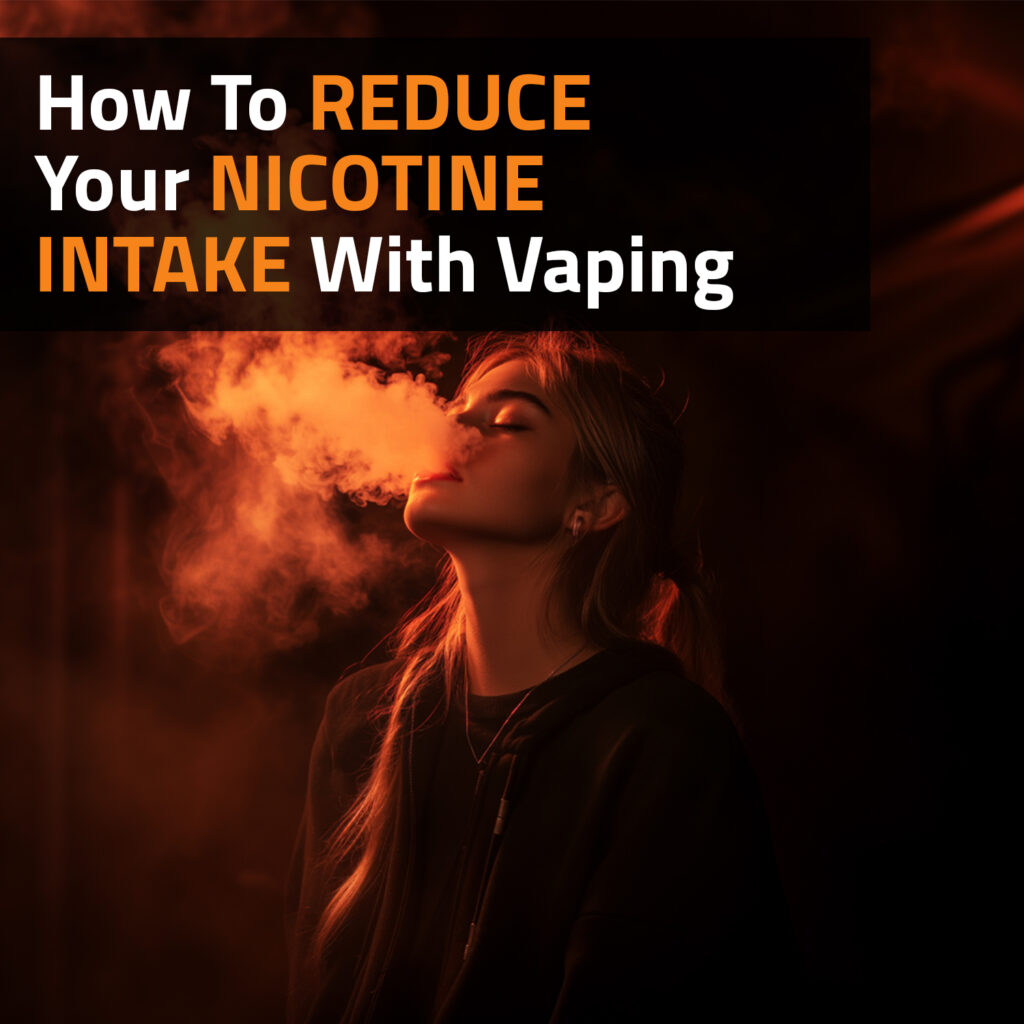Whether you are trying to quit nicotine altogether or just cut back to improve your health, vaping can be a flexible and effective tool to help you reduce your nicotine intake. With precise control over nicotine strength, customisable devices, and a wide range of e-liquids, vaping offers smokers a unique advantage in tapering down gradually without quitting cold turkey.
In this article, we will explore everything you need to know about reducing nicotine intake with vaping – from understanding nicotine levels to step-by-step strategies, product choices, withdrawal management, and common pitfalls to avoid.
Understanding Nicotine In Vaping
Before you begin the process of cutting down, it is important to understand how nicotine is delivered through vaping and how to interpret different strengths.
Nicotine Strengths
Nicotine levels in vape juice are usually measured in milligrams per milliliter (mg/mL) or as a percentage. Common strengths include:
- 50 mg/mL (5%) – Typically found in nicotine salt pods; very strong
- 20–35 mg/mL (2–3.5%) – Moderate to high strength
- 12–18 mg/mL – Mid-level for freebase nicotine users
- 6 mg/mL – Lower strength for lighter vapers
- 3 mg/mL or 0 mg/mL – Very low to nicotine-free options
Freebase Vs. Nicotine Salts
Freebase nicotine is harsh at high concentrations and suited to sub-ohm devices (which produce large clouds).Nicotine salts are smoother even at higher strengths, ideal for pod systems and mouth-to-lung (MTL) devices.
Why Reduce Nicotine Intake?
There are several motivations for lowering nicotine intake:
- Improved cardiovascular health
- Reduced dependence and cravings
- Better lung function over time
- Less irritability or anxiety when skipping a session
- Goal of quitting nicotine entirely
Step-By-Step Strategy To Reduce Nicotine Intake
1. Assess Your Current Usage
Start by tracking:
- How often you vape each day
- The strength of the e-liquid
- How many puffs per session
- When your cravings peak
This self-awareness will help you create realistic goals and track progress.
2. Choose The Right Device
Device type significantly affects how nicotine is absorbed:
- Pod systems (low-wattage, MTL draw) are efficient with higher strengths.
- Sub-ohm devices (high-wattage, DTL draw) require lower nicotine due to higher vapour production.
If you are planning to step down your nicotine levels, make sure your device supports variable wattage or voltage control, so you can adjust it alongside the nicotine strength for a smoother transition.
3. Gradual Reduction Is Key
Avoid large drops in nicotine strength. Taper slowly to give your body time to adjust. For example:
- Start at 20 mg and reduce to 15 mg
- Then move to 12 mg after a few weeks
- Eventually down to 6 mg, 3 mg, and 0 mg
Each stage can take 2–4 weeks, depending on your comfort level.
5. Reduce Frequency Before Strength
If you are vaping frequently, try cutting down how many puffs you take before lowering nicotine strength. This reduces the shock to your system when you eventually step down. Strategies include:
- Setting specific times for vaping (e.g., post-meal, not continuous)
- Avoiding chain vaping
- Replacing triggers with non-nicotine alternatives (e.g., gum, mints, water)
6. Switch To Lower-Nicotine Devices
If you are using high-strength salt nic in a pod, consider shifting to a freebase system. This gives you more freedom to use lower strengths and avoid overconsumption.
Coping With Nicotine Withdrawal Symptoms
As you lower your intake, you may experience:
- Headaches
- Mood swings or irritability
- Fatigue
- Cravings
- Difficulty concentrating
To manage these:
- Stay hydrated
- Exercise regularly (endorphin release helps)
- Keep your hands busy
- Use mindfulness or breathing techniques
- Remind yourself of your goal
Consider Nicotine-Free Intervals
Once you are comfortable at a lower nicotine level (e.g., 3 mg), consider using nicotine-free (0 mg) e-liquid during certain times of day or alternating days. This method:
- Helps break the psychological link between vaping and nicotine
- Keeps the hand-to-mouth ritual without feeding dependence
- Lets you enjoy flavors without the stimulant effects
Common Mistakes To Avoid
There are a few things you can do to ensure a successful experience, and some common mistakes that should be avoided.
Dropping Too Quickly
Sudden changes can backfire, causing intense cravings or relapse into higher nicotine or even cigarettes.
Underestimating Cravings
Have a strategy ready for when cravings hit – whether it is distracting yourself, going for a walk, or having a non-nicotine vape nearby.
Vaping More To Compensate
Many users vape more frequently at lower strengths to get the same satisfaction. This can be counterproductive. Always focus on both strength and frequency.
Ignoring Mental Habits
Even at 0 mg, psychological dependence on the vape can linger. Tackle behavioral triggers (like boredom or stress) to break the cycle completely.
Tips For Success
- Set clear goals: Are you aiming to quit nicotine altogether or just lower intake? Be specific. For example:
- “I want to be at 3 mg by the end of the month.”
- “I will switch to 0 mg for nighttime use.”
- Celebrate milestones: Each time you reduce a level, reward yourself with something healthy – a new flavour, hobby item, or relaxing activity.
- Track progress: Use a journal or vaping app to monitor nicotine strength, frequency, cravings, and mood. Seeing progress builds motivation.
- Involve supportive people: Tell close friends or fellow vapers about your goal. Join online forums or communities focused on nicotine reduction for added encouragement.
Can You Quit Nicotine Completely With Vaping?
Many ex-smokers have successfully transitioned from high-nicotine vaping to nicotine-free vaping and eventually to quitting entirely. The key is:
- Gradual reduction
- Clear, realistic goals
- Patience
- Emotional resilience
Alternative Nicotine Reduction Aids
If you need additional support, consider integrating:
- Nicotine replacement therapy (NRT): Like patches or gum
- Behavioral therapy: Helps address underlying psychological patterns
- Apps: Such as Smoke Free or QuitNow to track habits
- CBD vapes/e-liquids: Some people switch to cannabidiol-based e-liquids for relaxation without nicotine
Vaping offers a powerful, user-controlled way to reduce nicotine intake – often more flexible than traditional cessation methods. By selecting the right e-liquids, devices, and tapering strategies, you can reduce your dependence gradually and with greater comfort.
The process is not always linear. There may be setbacks, plateaus, or even temporary increases. But with persistence, a personalised plan, and supportive resources, you can move toward a healthier, lower-nicotine lifestyle – or eliminate nicotine altogether.






